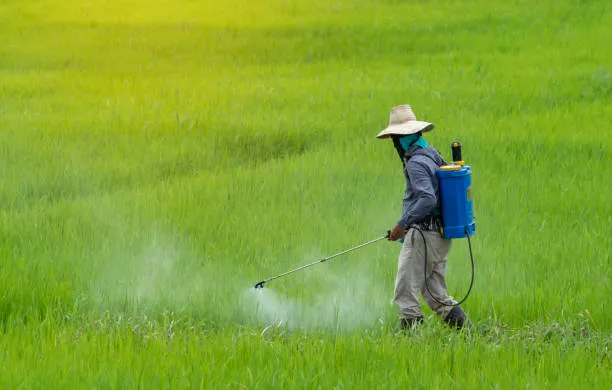Introduction
Insect pests cause significant damage to crops, leading to reduced yields and economic losses for farmers. To combat these pests effectively, Emamectin Benzoate 5% SG (Missile) has emerged as a highly effective insecticide with translaminar and systemic action. It belongs to the avermectin chemical family and is widely used against lepidopteran pests (caterpillars) in various crops, including cotton, vegetables, pulses, and fruits.
This blog provides a detailed, plagiarism-free overview of Missile insecticide, covering its mode of action, benefits, target pests, application methods, safety precautions, and resistance management strategies.
What is Emamectin Benzoate 5% SG (Missile)?
Missile is a soluble granule (SG) formulation containing 5% Emamectin Benzoate, a semi-synthetic derivative of abamectin. It is highly effective against leaf-eating caterpillars and provides long-lasting residual control.
Key Features:
- Chemical Class: Avermectin (Macrocyclic Lactone)
- Mode of Action: Neurotoxin (GABA & Chloride Channel Agonist)
- Formulation: 5% Soluble Granules (SG)
- Target Pests: Larvae of moths and butterflies (Lepidoptera)
- Crop Compatibility: Cotton, cabbage, tomato, brinjal, chilli, pigeon pea, soybean, and more
Mode of Action
Emamectin Benzoate works by:
- Disrupting nerve impulses in insects by binding to GABA (gamma-aminobutyric acid) and glutamate-gated chloride channels.
- Causing paralysis and death within 24–72 hours of ingestion.
- Providing translaminar movement (penetrates leaf tissues) and limited systemic activity (moves within the plant).
Key Advantages of Its Mode of Action:
- Fast-acting – Stops pest feeding quickly.
- Long residual effect – Protects crops for 7–14 days.
- Low risk of resistance when used in rotation with other insecticides.
Benefits of Emamectin Benzoate 5% SG (Missile)
- Highly Effective Against Resistant Pests – Works on pests resistant to conventional insecticides.
- Low Application Rate – Requires small doses per hectare (economical).
- Rainfastness – Adheres well to leaves, reducing wash-off.
- Safe for Beneficial Insects – Less harmful to pollinators and natural enemies when used correctly.
- Compatible with IPM – Can be integrated into Integrated Pest Management (IPM) programs.
Target Pests & Crops
1. Cotton
- American Bollworm (Helicoverpa armigera)
- Spotted Bollworm (Earias vittella)
- Pink Bollworm (Pectinophora gossypiella)
2. Vegetables (Tomato, Cabbage, Brinjal, Chilli)
- Tomato Fruit Borer (Helicoverpa armigera)
- Diamondback Moth (Plutella xylostella)
- Brinjal Shoot & Fruit Borer (Leucinodes orbonalis)
3. Pulses (Pigeon Pea, Soybean)
- Pod Borer (Helicoverpa armigera)
- Gram Pod Borer (Helicoverpa armigera)
4. Fruits (Mango, Pomegranate)
- Fruit Borers (Deudorix spp., Conogethes punctiferalis)
Recommended Dosage & Application Method
1. Foliar Spray (Most Common Method)
- Dosage: 0.25–0.5 g per liter of water (or 80–100 g per acre in 200–300 L water).
- Spray Timing: Apply at early larval stages for best results.
- Frequency: 2–3 sprays at 10–15 day intervals (depending on pest pressure).
2. High-Volume Spray (For Dense Canopy Crops)
- Use higher water volume (400–500 L/ha) for better coverage.
3. Best Practices for Application
- Spray in the evening to avoid UV degradation.
- Ensure thorough coverage (underside of leaves where larvae feed).
- Avoid spraying during flowering to protect pollinators.
Safety Precautions & Handling
- Wear PPE: Gloves, mask, goggles, and full-sleeved clothing.
- Avoid inhalation & direct contact – Wash hands after use.
- No eating/drinking during spraying.
- Storage: Keep in a cool, dry place, away from food and feed.
- Disposal: Triple-rinse containers before disposal.
Environmental & Resistance Management
- Toxic to Aquatic Life – Do not contaminate water bodies.
- Moderately Toxic to Bees – Avoid spraying during active pollination.
- Resistance Risk: Rotate with non-GABA inhibitor insecticides (e.g., spinosad, chlorantraniliprole).
Conclusion
Emamectin Benzoate 5% SG (Missile) is a highly effective, low-dose insecticide for controlling lepidopteran pests in multiple crops. Its unique mode of action, fast knock-down effect, and long residual activity make it a farmer-preferred choice.
However, responsible usage is crucial to delay resistance and protect non-target organisms. Always follow label instructions, rotate insecticides, and adopt IPM strategies for sustainable pest management.
Final Recommendations for Farmers
Monitor fields regularly for early pest detection.
Use at recommended doses – Higher doses do not improve efficacy.
Rotate with other MoA groups to prevent resistance.
By using Missile insecticide wisely, farmers can achieve better pest control, higher yields, and improved profitability.
Disclaimer: Always follow the product label and local regulations. Consult an agronomist for crop-specific recommendations.
Sourashis Chanda brings readers their unique perspective on Business, Economy, Health and Fitness. With a background in Health and Physical Fitness of 2years, I am dedicated to exploring [what they aim to achieve with their writing, on the sustainable Economy of the country, various pro tips about business, latest goverment news, with some tips in health are and Fitness.







